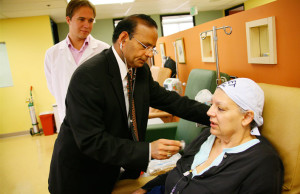Cancer Radiation Therapy
The type of medical procedure used to treat sarcomas depends upon the size of the tumor. Most small sarcomas (less than one inch or five centimeters) can be treated with surgery exclusively, but the majority of sarcomas are larger than five centimeters and routinely require a combination of surgery and radiation therapy. Radiation therapy when used in conjunction with surgery, can be used before, during, and after surgery.
Radiation damages the DNA of tumor cells making them sterile and as a result, a tumor cannot divide and multiply. For tumor cells that are beyond the reach of surgery, radiation can neutralize them. Since sarcomas can spread along muscles and between them in ways that usually cannot be seen or felt, radiation targets a perimeter of tissue that surrounds the tumor. Microscopically, sarcoma cells are discrete, but they can trickle out deceptively and remain after surgery. The further away from the tumor site, however, the likelihood of sarcoma cells is less feasible. Radiation oncologists typically irradiate tissue five to 10 centimeters (approximately two inches) beyond the tumor site.

Brachythera py
py
Brachytherapy, which involves delivering radiation therapy locally, can be administered in one of two different ways to treat soft tissue sarcoma. In one approach following removal of the tumor, the surgeon inserts special tubes (catheters) into the tumor bed. After allowing the surgical wound five to six days to heal, the radiation oncologist inserts radioactive seeds into each of the catheters. The seeds stay in place for several days (usually five days) delivering a high dose of radiotherapy to the site. When the treatment is completed, the radioactive seeds and catheters are removed.
It takes an estimated 10 to 14 days following surgery for the treatment to complete. More complex cases might require administering brachytherapy for two to three days combined with external radiation for five weeks.
External-Beam Radiation Therapy
This is a technique that applies radiation doses from outside of the body directly to the region of the tumor and surrounding tissues. This approach is most useful for sarcoma tumors in the chest and retroperitoneum (the area outside or behind the peritoneum, which is the tissue that lines the abdominal wall and covers most of the organs in the abdomen) where catheters cannot be feasibly placed. It is typically a seven to eight week outpatient process in which the patient comes in five days a week for a few minutes worth of radiation therapy. It can be given before or after surgery.
IMRT
Intensity modulated radiation therapy (IMRT), is a new and sophisticated computer-guided technique that can treat sarcomas prior to surgery. The procedure allows safe delivery of much higher doses of radiation directly to the tumor while sparing the normal surrounding tissues. The goal is to use IMRT to shrink the tumor to result in a more successful surgery and reduce the chance of recurrence and improve the ability to preserve as much limb and healthy tissue as possible. Since sarcoma tumors can sometimes be very close to the spine or major blood vessels, this targeted therapy can provide tremendous benefit to the patient.
Contact the Sarcoma Oncology Specialists Today
Sarcoma Oncology Center offers patients the best possible solution through its multi-modal approach. We respect the physical and emotional well-being of each individual and are dedicated to teaming with our patients throughout treatment. Please contact our center at 310-552-9999 to schedule a consultation with one of our oncologists. Learn more about the Sarcoma Oncology Center’s multi-modal treatment approach.
Next, read about Cancer Surgery.





